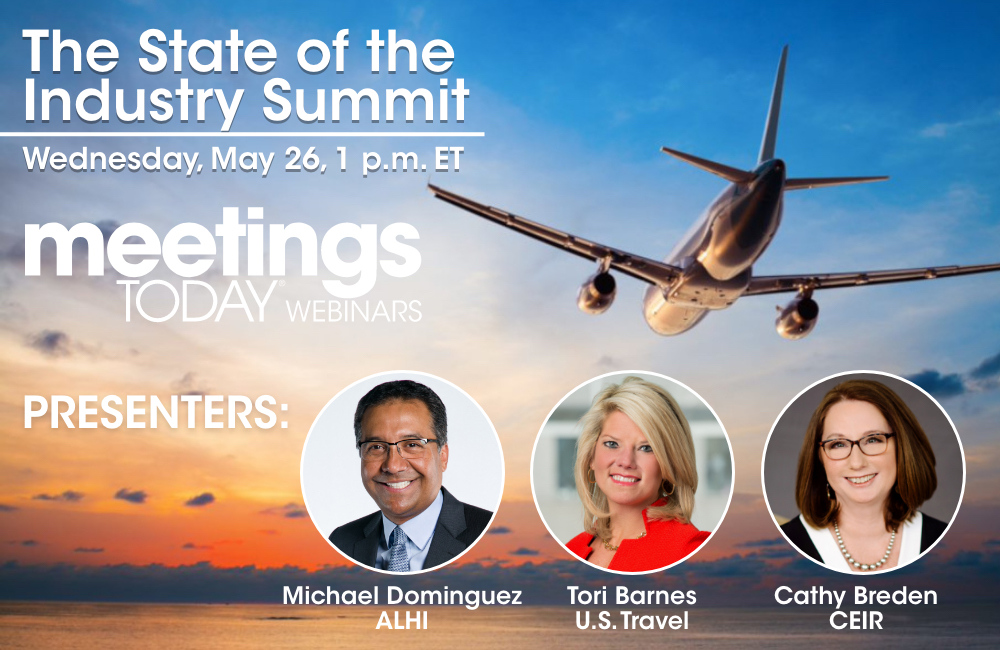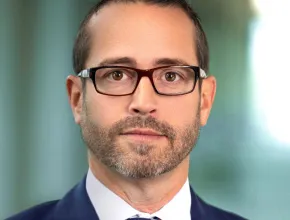With vaccines being widely distributed and local governments relaxing restrictions on gatherings, it seems the thaw is on in the meetings and events industry.
Meetings Today checked in with five industry experts to see where they think we are on the road back to in-person meetings:
- Adam Sacks, President, Tourism Economics
- Jeffrey Emenecker, Senior Director of Analytics, Cvent
- Michael Pinchera, Senior Editor, MPI
- Cathy Breden, CEO, Center for Exhibition Industry Research
- Don Welsh, President & CEO, Destinations International
Watch Our Free State of the Industry Webinar May 26!
Adam Sacks, President, Tourism Economics

What is your general opinion on where we are at as an industry in terms of recovering from the pandemic?
The meetings industry is ready for takeoff. More specifically, it’s accelerating down the runway and will soon be airborne. I spoke at a live event of more than 1,000 people last week and will be speaking at another conference next week. We’ll need to be patient, but the recovery is happening now.
What are some positive signs/statistics/booking trends you’re seeing at the moment?
The pace of new bookings is strengthening for our DMO clients and we expect to see about 70% of 2019 levels in the fourth quarter of this year across many U.S. markets.
Another very interesting statistic from the U.S. Census: Vaccine hesitancy among those with a college degree is just 9%. (It’s 24% for those with just a high school diploma.) While I will refrain from social commentary on these stats, they tell an important story for the recovery of meetings given that most meetings attendees have a college degree. The takeaway is that more than 90% of your fellow meeting attendees will be vaccinated. This should produce tremendous confidence.
What do you believe will be the first industries/organizations to return to large in-person meetings, and which ones will return later?
Tradeshows and professional service conferences are highly motivated to meet and we are hearing anecdotal reports of significant pent-up demand for events that were canceled last year.
When do you think international in-person meetings will recover, and why?
Our models indicate a modest return in 2022 and strong rebound in 2023. A prolonged full recovery period—likely to 2024 or 2025—will be a function of corporate travel policies, longer vaccination periods in parts of the world, tempered travel confidence for international travel, and the slow return of air service.
What part of what we’ve been through in the past year-plus will become a permanent feature of the meetings/events/exhibition industry?
It’s likely that the pandemic has accelerated the adoption of a hybrid meetings model. However, this will expand participation more than it will cut into in-person participation. Virtual events are built on a foundation of in-person relationships. Without the community built through face-to-face relationships, virtual meetings will lose attractiveness over time. The in-person experience is far superior and will re-establish itself as the centerpiece of meetings.
What lessons do you think the hospitality/travel /meetings/exhibitions industries should have learned during this unprecedented period?
On the other side of this, we will learn once again that meetings are indispensable. We will learn to be more skeptical of those who declare in the midst of a crisis that meetings will never fully rebound. The competitive advantage of face-to-face meetings is real, substantial and will endure as a motivation[.
[Related: 2021 Meetings Today Trends Survey]
Jeffrey Emenecker, Senior Director of Analytics, Cvent

What is Cvent noticing through its network about future bookings in the MICE segment?
At a high-level, demand is picking up steadily with a continued upward trajectory. The mix of meetings in the nearer term—for spring and summer 2021—RFP volume is still less than normal, but into the fall and winter there seems to be increased planner confidence reflected in a mix of meetings that are relatively normal through the remainder of the year.
What types of groups will resume in-person meetings first, and which do you anticipate being among the last to book in-person meetings?
Social has been among the first to resume in-person meetings. Anecdotally, many people, even outside of the industry, are aware of the strong demand for weddings. Corporate is continuing to climb, and while it makes up more than 50% of RFPs, it is not quite at the same levels as pre-pandemic.
What U.S. destinations are experiencing the most in-person meetings bookings, and which the least?
Beginning in March we started to see positive signs of a return in urban and northern markets. April marked the second month in a row that major metros performed better than mid-sized metros, correcting the 2020 trend in which mid-sized metros led RFPs.
The highest volume in April continued to be most robust in Florida, with strong activity in other warmer markets in California, Arizona and Texas. Looking forward to the rest of 2021, and into 2022, we’re seeing continued pace in Orlando, Phoenix/Scottsdale, Ft. Lauderdale, Miami, Tampa/St. Pete, Nashville, Northern Jersey and Dallas/Ft. Worth, all of which have been overperforming, raising the bar even as all markets are doing better.
What changes to the formats of meetings and conventions do you anticipate through the end of 2021?
Certainly, we’re seeing RFPs for more hybrid meetings than ever before. Interestingly, many of these RFPs report that they expect at least 50% of attendees to be in person, signaling a strong desire for in-person components.
Our experience has been that planners become more comfortable with hybrid as the planners themselves see hybrid events efficiently and safely executed. This year Cvent CONNECT will be hybrid, so our planning team can very much empathize with the challenges that accompany preparing for one event with two experiences.
What changes to the formats of meetings and conventions do you anticipate in 2022 and beyond?
We’re seeing more larger meetings being sourced, with this trend becoming more pronounced the further out the arrival date—likely because these meetings are finally viable. In Q2 2021, 82% of meetings are for less than 25 attendees, but 27% of the meetings being sourced for 2022 and beyond are 200-plus-person events.
Any other thoughts about the state of the MICE industry?
The CDC’s recent announcement that recommends fully vaccinated people are safe without masks will certainly have a lot of implications. It might be too soon to determine exactly what impact this will have around the size and frequency of events, but it is certainly another macro consideration as we analyze the data.
As rates return to 2019 levels for late 2021 and 2022 dates, the pace of demand is about 46% of pre-pandemic levels for 2021 dates and 61% for 2022 dates with the summer of 2022 increasing pace the most over the past 30 days.
[Related: Cvent Execs Talk Trends and CONNECT Virtual]
Michael Pinchera, Senior Editor, MPI

What is your general opinion on where we are at in terms of recovering from the pandemic?
This varies greatly by country and region. The availability of effective vaccines and the corresponding elimination of travel and gathering restrictions is paramount to our industry’s recovery. The latest MPI Meetings Outlook data does reveal some of the expected timing for the recovery. More than 50% of all respondents expect to host their next in-person meeting/event in Q3 or Q4 this year. Meanwhile, 45% and 32% of respondents expect their business to be back to pre-pandemic levels in 2022 and 2023, respectively.
What are some positive signs/statistics/booking trends you’re seeing at the moment?
MPI’s quarterly Meetings Outlook report provides a wealth of insight into current and future business trends through the direct input of industry professionals. A few data points of note that show the recovery in action (and the expectation that industry pros have for a solid recovery):
- Employment trends, for which we ask about the current climate, have shown steady—albeit, not massive—growth since last summer. The percentage of survey respondents indicating growth in full-time hiring has gone from 4% (summer 2020) to 6% (fall 2020) to 10% (winter 2021) to 18% (spring 2021—the latest survey). While promising, this is still below the 33% of respondents who said they were hiring full-time positions in spring 2020.
- Our big-picture outlook—projected business conditions over the next year—has seen incredible improvement, with 81% of respondents indicating a favorable year ahead. That’s the largest favorable percentage we’ve seen in the seven-year history of Meetings Outlook. Similar to the hiring trends, this positive data point has steadily gotten better for each of the past four quarters: from 36% (summer 2020) to 58% (fall 2020) to 65% (winter 2021) and now 81%.
What segments of the hospitality/travel/meetings/exhibitions industries face the biggest challenge in the near future, and how do you think they will adapt?
According to Meetings Outlook respondents, the domestic corporate and domestic association segments are seeing the greatest increase in activity. It’s been that way for the past three quarters. International corporate and international association activity, meanwhile, has been reported as having the greatest decrease in activity. Of course, the complexities of professionals moving across international borders—with travel restrictions, the lack of vaccine availability in many locations, etc.—logically suggests business for international meetings groups will return at a slower pace.
What part of what we’ve been through in the past year-plus will become a permanent feature of the meetings/events/exhibition industry?
Virtual/digital and hybrid are here to stay. This won’t remain at the same level that we’ve seen throughout the pandemic—face-to-face gatherings will always be sought after for many reasons—but more organizers and groups now have the necessary experience with virtual/digital and have a clearer idea of when remote connectedness is sufficient to achieve their goals.
I hope handshakes and hugs return fully, but at the same time, I believe that enhanced cleanliness protocols aren’t going anywhere—alcohol gels and more regular cleaning of high-touchpoint items and spaces.
So many venues have installed more extensive air filtration systems—and the pandemic has increased awareness in the general public as to the importance of such technology. Post-pandemic, perhaps some venues will decide not to install enhanced air management systems, but I anticipate this will remain a selling point for the venues that have or will install them…and the topic will continue to be discussed in the meetings industry as the technology evolves.
What lessons do you think the industry should have learned during this unprecedented period?
We’re all in this together. Over the 18 years I’ve been writing about and researching the meeting and event industry, I’ve heard that refrain every time there’s a significant impact on the business of planners or suppliers. Relationships are essential. It may be a strong buyer’s market right now, but soon it’ll be a seller’s market. Industry pros have to be good partners for their counterparts no matter who is up or down because the market constantly shifts back and forth, and you need to have those solid relationships in order to succeed.
Beyond that, I think the public has a much greater appreciation for in-person meetings and events than perhaps ever before. The pandemic has really shined a spotlight on the human need for face-to-face connections. However, we can’t rest on our laurels, we must continue to advocate for the industry and espouse the values of face to face—as memories of the pandemic increasingly recede years from now, individuals and governments may again take these experiences for granted.
I also sincerely hope that meeting pros use this time of building back to more thoroughly embrace diversity and inclusion. Again, we’re all in this together—COVID-19 is a worldwide problem that doesn’t care about your nationality, ethnicity, gender, etc. That everyone is affected highlights our connectedness on many levels. No country or type of person alone could solve the pandemic.
We need each other and we need to learn from each other. Everyone brings something different to the party. I believe organizations in the meeting industry that refuse to embrace diverse voices (including in leadership roles)—or fail to strive to include the many variations of humanity in their efforts—well, they don’t have much of a future.
Cathy Breden, CEO, Center for Exhibition Industry Research

What is your general opinion on where we are at, at this moment, as an industry in terms of recovering from the pandemic?
Speaking from the B2B exhibitions perspective, the industry is optimistic, but there is still a great deal of uncertainty.
- Organizers: The liability they hold in the event cases in the city rise and some type of restrictions are put into place. Pandemic insurance is not available and they are not able to protect their asset…which is their show.
- Budget cuts will restrict attendance—both buyers and exhibitors. ExhibitiorMedia research reveals budgets are 40% lower than in the past.
- Many organizers have pivoted to holding virtual events. CEIR research indicates organizers will continue holding digital events into 2022 (64%).
- Some company travel bans may still be in place, at least through Q3.
- Will there be enough labor to service the shows? Carpenters, electricians, housekeepers, wait staff, etc.
What are some positive signs/statistics/booking trends you’re seeing at the moment?
We know that Q3 and Q4 of this year are going to be very busy for show organizers and the gamut of service partners—the contractors, venues, hotels and all those who are employed by them. The B2B exhibitions industry is closely tied to GDP. GDP is strong and the underlying fundamentals of the economy are strong. This bodes well for B2B exhibitions.
What do you believe will be the first industries/organizations to return to large in-person meetings, and which ones will return later?
Construction, manufacturing, raw materials (i.e., oil and gas) will be first. Medical/healthcare will be last. Professional business services (CPAs, financial)—those professions where licensure renewals are required. Many have pivoted over the last year taking online courses for CEs will be one of the last.
If approval of an infrastructure bill goes through, that will bode especially well for construction, manufacturing, raw materials and transportation.
[Join Cathy Breden and other industry professionals for a live webinar on this topic.]
When do you think international in-person meetings will recover, and why?
In my world large in-person meetings are tens of thousands of people. CEIR research is telling us that as of now the earliest is toward the end of 2022 and into 2023. Depends on continued falling cases of COVID, vaccines, virus variants, etc. We don’t know what these new variants of the virus are and how they will impact vaccines. Also, when will booster shots be needed, or if they will even be needed?
What segments of the hospitality/travel /meetings/exhibitions industries face the biggest challenge in the near future, and how do you think they will adapt?
We have seen exhibition organizers adapt over the past year by offering digital events, both with an online marketplace and without. As of now, research tells us that corporate marketers prefer face-to-face [to digital for the following reasons]:
- 52% lack of leads/sales opportunities
- 44% difficulty building/maintaining relationships
- 29% inability to launch new products as planned
- 59% inability to increase brand awareness
Experimentation will continue to find the mix of ingredients that works for corporate marketers, attendees and the organizers. A hybrid event is really two separate events. Both take time, different skill sets and resources.
IAEE has recently launched a 365-day marketplace: MarketHub. Other organizers will do the same.
What part of what we’ve been through in the past year-plus will become a permanent feature of the meetings/events/exhibition industry?
Some elements of digital will remain. It remains to be seen how the digital marketplace will evolve as technology improves.
What lessons do you think the hospitality/travel /meetings/exhibitions industries should have learned during this unprecedented period?
I am reminded of the 2001 and 2009 recessions [compared to] what has happened over the last year and a half. During these times, we collectively came together as different industry segments and collaborated to make sure we all got through the difficult times together. We joined forces on lobbying efforts and legislation. This time it has been more true than ever. It seems that each time some crisis occurs, it takes time for us react. We collectively as an industry need a crisis plan with different scenarios so we are ahead of the curve to better serve our collective stakeholders.
Don Welsh, President & CEO, Destinations International

What is your general opinion on where we are at as an industry in terms of recovering from the pandemic?
With each growing day, there seems to be a growing confidence in planning in-person meetings. This is being driven by the increase of vaccinations and federal, state and local ordinances allowing in-person gatherings. Convention centers, hotels and airports continue to adapt to the changing environment and improve health and safety standards.
What are some positive signs/statistics/booking trends you’re seeing at the moment?
I look at our own events that are about to take place, such as our hybrid CEO Summit in Tampa, Florida, and our Annual Convention in Baltimore. Once registration opened for both, we had an immediate surge of in-person registrations. And for those not able to join us in person because of issues like border closures, they are choosing to attend virtually.
What do you believe will be the first industries/organizations to return to large in-person meetings, and which ones will return later?
I am proud that our industry has taken the lead on many of the larger gatherings. WTTC had the bold decision to hold their meeting in Cancun, Mexico, with over 600 delegates from around the world. PCMA, IMEX and MPI are also taking the lead in the return of in-person gatherings which are very important for meeting organizers and destinations.
When do you think international in-person meetings will recover, and why?
I believe when borders are safely reopened and flight options are increased, we will see a slow recovery in international meetings and delegations.
What segments of the hospitality/travel /meetings/exhibitions industries face the biggest challenge in the near future, and how do you think they will adapt?
Based on many of the current restrictions at corporations, which preclude their employees from traveling for business, I believe that the technology companies could be the slowest to recover. I hope I am wrong!
What part of what we’ve been through in the past year-plus will become a permanent feature of the meetings/events/exhibition industry?
I have to believe that a hybrid experience will be with us for the future. This past year has proven that many work activities can be accomplished virtually. However, we do know that nothing can replace the personal relationships that are built by meeting face-to-face.
What lessons do you think the hospitality/travel /meetings/exhibitions industries should have learned during this unprecedented period?
I am very proud of what our destination organization/CVBs have done for their communities during these challenging times. I believe that many meeting organizers have a greater understanding of the role and the services that a CVB can provide to them in planning successful events. I also believe that local residents, civic leaders and elected leaders have a much greater appreciation and understanding of what a CVB does for their communities.
Any other thoughts? As difficult as the pandemic has been, there have been a few silver linings along the way.
Collaboration has never been higher amongst the industry and I don’t see that slowing down in the near future. Everyone in our industry continues to share best practices to help our industry recover in every sector. And most importantly, travel is part of the human DNA and we are seeing record numbers of bookings throughout the world as vaccination rates increase and health and safety guidelines are in place and practices.
Read Next: Benchmark Reveals 10 Meetings Trends as the Pandemic Wanes








